
Alexander Mikhailovich Prokhorov was a Russian physicist and researcher on lasers and masers in the former Soviet Union for which he shared the Nobel Prize in Physics in 1964 with Charles Hard Townes and Nikolay Basov.

Marshal of Aviation Ivan Nikitovich Kozhedub or Ivan Mykytovych Kozhedub was a Soviet World War II fighter ace. Universally credited with over 60 solo victories, he is considered to be the highest scoring Soviet and Allied fighter pilot of World War II. He is one of the few pilots to have shot down a Messerschmitt Me 262 jet, and the first Soviet pilot to have done so. He was made a Hero of the Soviet Union on three occasions. After World War II, he remained in the military and went on to command the 324th Fighter Aviation Division during Soviet operations in the Korean War.
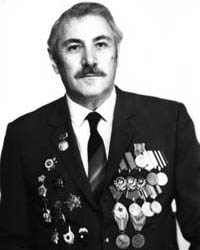
Grigory Naumovich Chukhray was a Ukrainian Soviet and Russian film director and screenwriter. People's Artist of the USSR (1981). He's the father of the Russian film director Pavel Chukhray.

Leonid Mikhaylovich Sandalov was a Soviet military leader with the rank of colonel-general. During World War II, he led staffs of the armies and fronts. After the war, he led the staffs of military districts, he was Deputy Chief of Staff of the Army. He received various awards for his service. A talented and prolific memoirist and military analyst. Honorary Citizen of Vichuga, Kobrin, and Riga.

Oleg Aleksandrovich Strizhenov is a Soviet and Russian stage and film actor. People's Artist of the USSR (1988).

Georgy Filippovich Baydukov was a Soviet test pilot, Hero of the Soviet Union (1936), writer and hunter.
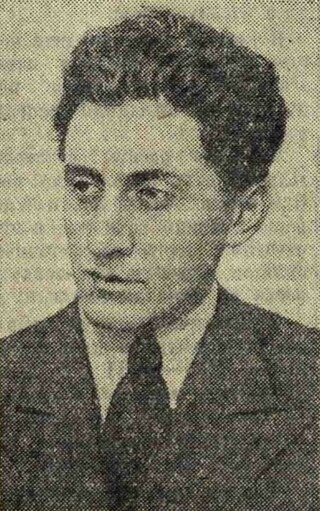
Lev Yefimovich Kerbel was a Soviet and Russian sculptor of socialist realist works. Kerbel's creations included statues of Karl Marx, Vladimir Lenin, Yuri Gagarin, which were sent by Soviet Government as gifts to socialist and the Third World countries across the world.
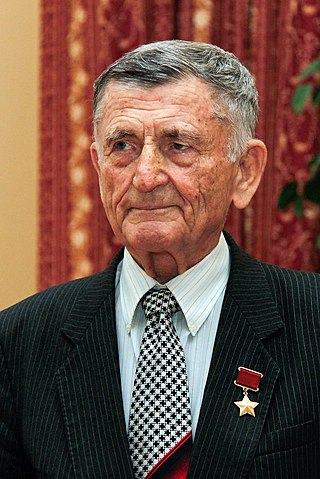
Sergei Makarovich Kramarenko was a Soviet Air Force officer who fought in World War II and the Korean War. For his service in Korea he became a holder of the Title of Hero of the Soviet Union. He achieved several high command positions in the USSR and was also Air Force advisor in Iraq and Algeria in the 1970s. Retired in 1977 with the rank of major-general, he lived with his family in Moscow.

Vasily Mikhailovich Badanov was a Soviet military officer and general, best known for his leadership in the Tatsinskaya Raid (1942) and subsequent command of the 4th Tank Army (1943–1944).
Pyotr Dmitrievich Grushin was a Soviet rocket scientist and, from 1966, an academician of the Academy of Sciences of the USSR.
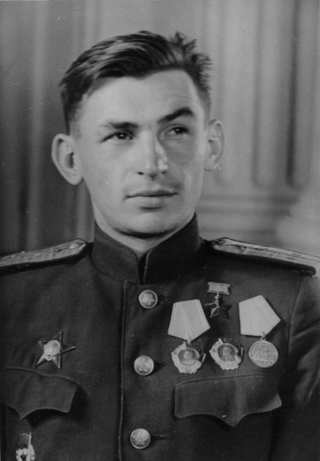
Vasily Vasilyevich Reshetnikov was a Soviet pilot who served during World War II. Reshetnikov flew 307 missions, mainly as a pilot of a long-range bomber, and in the summer of 1943, received the title of Hero of the Soviet Union. After World War II, he was named commander of an Aviation Division, Air Corps. Reshetnikov was subsequently promoted to Colonel General and took command of the Long-Range Aviation branch from 1969 to 1980 and was made Deputy Commander-in-Chief of the Air Force of the Soviet Union from 1980 to 1986.

Vladimir Ivanovich Dolgikh was a Russian politician who was head of the Metallurgical Department of the Central Committee Secretariat of the Communist Party of the Soviet Union. He was a candidate member (non-voting) of the Politburo from 1982 to 1988.

Ivan Fedorovich Ladyga was a Soviet-Ukrainen colonel of artillery. He was a Candidate of Military Sciences, a professor, and a corresponding member of the Russian Military Sciences Academy. He was given the award of Honoured Worker of Higher Education of the Russian Federation, and a veteran of World War II Ladyga was one of the authors of the Soviet doctrine for using Strategic Missile Troops in combat. Born in 1920 in the village Manuylivka, USSR.

Stepan Ivanovich Naumenko was a Soviet MiG-15 pilot during the Korean War, credited as the first Soviet ace in the conflict. Estimates of his number of victories range from two to six, although most indicate five.

Naum Semyonovich Shusterman was a lieutenant colonel of the Soviet Union, who served as the chief engineer of the 43rd Soviet Fighter Aviation Regiment during the Great Patriotic War.

Klavdia Yakovlevna Fomicheva was a squadron commander in the 125th Guards Dive Bomber Regiment during the Second World War who was awarded the title Hero of the Soviet Union on 18 August, 1945.

Stepan Nikolayevich Borozenets (Russian: Степан Николаевич Борозенец; 20 August 1922 – 26 August 2016) was a Soviet Air Force colonel and a Hero of the Soviet Union.
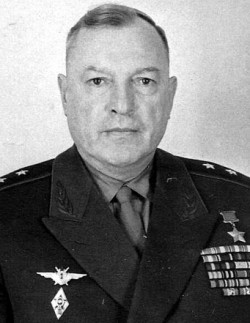
Georgy Ageevich Lobov was a Soviet fighter pilot and squadron commander of the 7th Guards Fighter Aviation Division during World War II who was credited with 10 solo and 7 shared aerial victories. He later commanded the 64th Fighter Aviation Corps, during the Korean War.

Boris Mikhailovich Tenin was a Soviet and Russian stage and film actor and pedagogue. People's Artist of the USSR (1981).
Mazahir Hamid oghlu Abasov was an aviator, doctor of historical sciences, professor, laureate of the Shohrat Order.


















